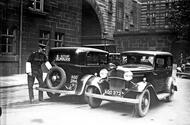We take communications for granted now, but it was very different story in 1930s Britain
We take for granted these days that communications will be easy, instant and possible everywhere.
Indeed, almost everything in the modern world relies on it being so: just see what happens when the wi-fi drops in an office. It’s therefore fascinating to see how complex such simple things used to be.
Imagine you park your car on a London street and return an hour later to find it distinctly absent. You would pull your smartphone out of your pocket, ring 999 and inform the police. The call handler would send a digital report to a dispatch, who would then relay it to police officers and their patrol cars by way of encrypted radio signals.
Back in the 1930s, as we found out on a visit to the Metropolitan Police’s headquarters, it was a much more involved process.
Enjoy full access to the complete Autocar archive at themagazineshop.com
You as the victim had to locate a Post Office phone box or police box (that’s a Tardis if you’re under 60) to get help. In Scotland Yard’s big, airy information room, a call handler sitting at a desk topped by a telephone indicator board of red and white lamps would take your call immediately – it having bypassed the usual switchboard – and write the details of the crime on a pad in a shorthand code.
They would then walk over to one of the room’s map tables, on which would be a number of counters, each representing a patrol car, and put a red hoop over one to indicate its assignment to the job.
They would next walk to a colleague sitting at another desk, who would relay the message to patrol cars by tapping on a Morse code key. The bleeps would be broadcast by a station in West Wickham, Kent (which had a diesel generator in case of a power cut), decoded by the officer in the passenger seat and relayed to the driver, who would then give chase.
Not all of the cars had a two-way communication system, in which case the officers would on leaving a job have to find a phone to report back to the information room that they were available once again.
Don’t think all these steps made crime fighting slow, though: we heard of a car being recovered less than 20 minutes after it had been reported stolen, despite it being a common one and the victim being unable to recall its numberplate.
We also take for granted now that everything can and will be recorded. Literally trillions of photos and videos are captured every year on smartphones, and of course those videos feature extremely high-fidelity audio.
Back in the 1930s, capturing a video required all manner of hefty camera and audio equipment and even a purely auditory recording was a very involved undertaking, as we found when showed around the new truck that had been built for the record label His Master’s Voice (that’s what the little dog is listening to in the HMV logo).
This was to enable the record pressing and non-live broadcasting of things that couldn’t be recorded in a studio, “His Majesty the King opening a conference on India at the Houses of Parliament, the Aldershot Tattoo, the Trooping of the Colour, the singing of nightingales, or the characteristic sounds of a submarine submerging being cases in pointâ€. Cor. To imagine that some people wasted their money on swing music instead!
Built on a 30hp Lancia chassis at a cost of £10k (or £600k to us), HMV’s truck was 7m long and weighed 7.6 tonnes.Â
It could be used almost anywhere, having some 1800m of connecting cable and five jacks to raise it dead level. Inside was “a self-contained recording unit, with two separate complete channels consisting of duplicate amplifiers and recording machines, four microphones and a host of detail apparatusâ€. The required electricity came from a special 456V battery set, charged by an on-board 1.5hp generator.
The actual recording machine was driven by a gravity motor to ensure the turntable would spin at exactly 78rpm while the inch-thick wax disc atop it was engraved by a sapphire-tipped stylus in reaction to currents from the microphones. Meanwhile, a vacuum tube sucked away the carved-out strips of wax.
Playing this disc would ruin it, unnervingly for the recordist; they had to wait for it to be converted into a commercial disc through electrolytic processes, master matrices and metal moulds.

